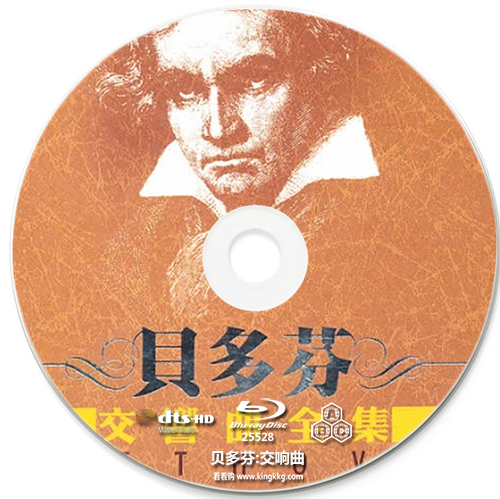- 产品参数
- 产品详情
配置:
声音:原声LPCM/原声DTS-HD
字幕:德文/英文/法文/意大利文/西班牙文
Abbado's studio recordings of the Beethoven symphonies, from 2000, were intriguing readings that didn't quite capture the music's scope. Later that year Abbado was diagnosed with cancer, and the brush with mortality seemed to deepen his partnership with the Berlin Philharmonic. These 4 DVDs capture live performances from 2001 that unite the Philharmonic's polished sound with insights from the period instrument movement. Everything here bristles with an intensity that eluded the studio versions, especially in the "Eroica,'' Fifth, and Seventh symphonies. Some Bostonians will be reminded of a gripping and emotional all-Beethoven concert at Symphony Hall by these same forces just weeks after 9/11. -- Boston Globe, David Weininger, January 2010
These recordings were apparently derived from the same concerts that produced a box set of the symphonies issued only last year by DG; the Ninth was recorded in concert a year earlier at the same time as the sessions which produced the recording included in the DG box issued in 2000 (Eike Wilm Schulte replaces Thomas Quasthoff). For those who own either box, these DVDs are self-recommending. Other listeners may rest assured that there are many reasons to acquire this set.
Abbado has been the most successful of contemporary conductors of Beethoven symphony cycles at blending period and modern orchestra performance practices. Where Barenboim is the staunch traditionalist, unafraid to appear to be reactionary in his single-mindedness, Haitink is the centrist, as ever, and Rattle is the pragmatist, picking and choosing (and not always successfully, in the final analysis), Abbado brings to the richness of the modern ensemble the brisk tempos and fresh-sounding spirit of the period-instrument movement.
In the first two symphonies, for example, one can now see that the Berlin strings have been reduced to 8-8-6-4-3 proportions, and the winds and trumpets are in pairs, yet there is no loss of fullness or impact in the sound (PCM, Dolby, and DTS 5.1 are available); instrumental detailing and transparency are exceptional. The orchestra is augmented appropriately as the cycle progresses, obtaining more heft but with no resultant loss of immediacy or agility. In general, these performances are more expansive, particularly in the slower movements, when compared to those in the original DG set. Yet, they are also more emphatic, more sharply etched, representing Abbado's continuing efforts to approach the music afresh, and they never fail to enhance his already extremely convincing interpretations.
Abbado's "Eroica" is one of the finest on disc, and the video provides the visual accompaniment that enhances the power transmitted through the audio performance. This is one of the recordings--there is one for each of the four DVDs--with a multi-angle feature, allowing the viewer to utilize the "Conductor Camera" focused exclusively on Abbado; watching him is to experience an individual possessed by--and in possession of--the spirit of the music, intent on communicating that spirit to his players. The Marcia funebre is a perfect example of the strength of Abbado's vision: paced halfway between Gardiner's briskly flowing tempo and Barenboim's truly funereal one, this is music of grim determination and sweep, never dragging but never breathless: Beethoven in excelsis.
One aspect of the videos not available to the auditor of CDs is to note the rotation of personnel from symphony to symphony; this admirably democratic practice affords one the chance to marvel at the uniform excellence of this ensemble. Surely one of the pleasures of these DVDs is to watch as well as listen to this superb orchestra.
The bonus is 26 minutes of Abbado's observations on Beethoven's music, delivered in Italian with subtitles. The maestro is clearly pleased with the work of his orchestra: "We conducted a give and take. A conversation about Beethoven. We breathed in unison in creating these symphonies." And on reducing the size of the orchestra for these concerts: "This also helps the musicians to hear each other play . . . all Berlin Philharmonic members are chamber musicians. Teaming up with them was an ideal opportunity." He compares the omission of repeats to the amputation of a limb, and stresses the importance of fidelity to Beethoven's metronome marks. One observation might serve as Abbado's creed: "I believe one fact is crucial: works like Beethoven's symphonies are boundless masterpieces. You can always find something new in them, something to increase your knowledge of the score, to discover new facets. Throughout my career I found it logical to constantly seek something new."
Perhaps the most poignant observation I can make is to compare the conductor of the Ninth Symphony, recorded almost a year before the others, with his appearance in the later concerts. Abbado had suffered a life-threatening illness (stomach cancer), and the physical toll is all too obvious; it is a tribute both to the resilience of Abbado's own spirit and to the life-giving qualities of great music that these concerts are such a triumphant success. -- Fanfare, Christopher Abbot, December 21, 2009
